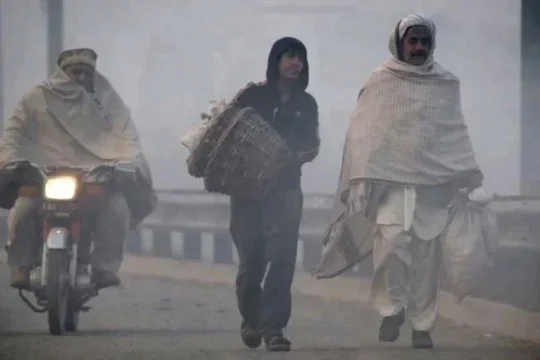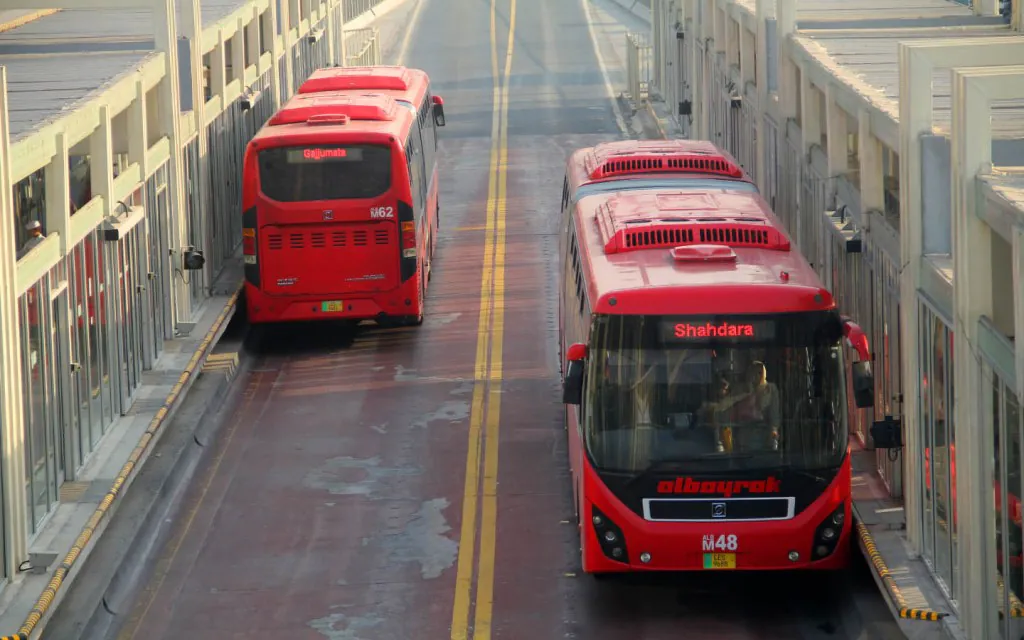
Lahore is a city in Pakistan with many attractions and is one of the most vibrant cities in the province of Punjab. In terms of administration, this city has seen many changes in recent years, one of which is the Lahore Metro Bus service. This bus service began for the general public and is one of the faster bus services. Metro Bus offers a neat, clean, and quick public transportation service.
Lahore
Lahore, also known as Lhawr in Urdu, is Pakistan’s second-largest city and the capital of the Punjab province. The Ravi River, an Indus tributary, is located on the upper Indus plain 811 miles (1,305 kilometres) northeast of Karachi.
Almost nothing is known about the settlement’s history prior to the Muslim era. Lahore was named Lhawr after Lava, or Lh, the son of Rama, according to Hindu tradition. The city of “Labokla,” which could be Lahore, is mentioned in Ptolemy’s 2nd-century Guide to Geography.
Lahore Metro Bus Service
Lahore, Punjab’s most populous metropolis and administrative centre, has grown rapidly in recent years. The city beautifully combines ancient history with the available modern infrastructure. The Azadi Chowk Metro Station stands against the stunning backdrop of Badshahi Masjid.
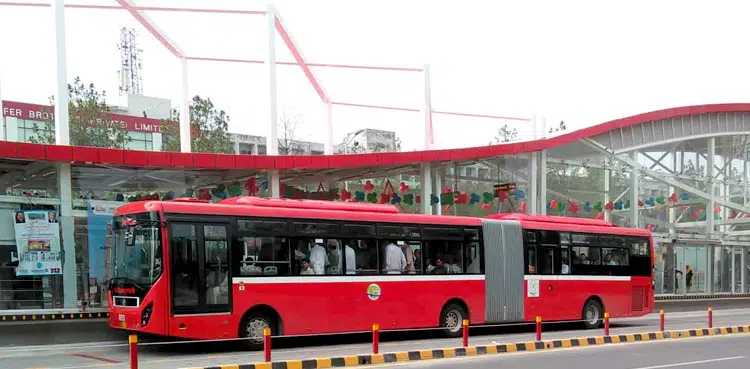
Large projects, such as the Ring Road and the Kalma Chowk Flyover, have helped reduce traffic congestion in Lahore. The Lahore Metro bus, widely regarded as Pakistan’s first Bus Rapid Transit (BRT) service, is now another major effort to modernise the city’s public transportation system. Islamabad has also launched an Islamabad metro bus service.
In Lahore, Pakistan, the Metro bus is a rapid bus system. Some of its characteristics are as follows:
- The Lahore Metro bus service is connected through the Lahore Transport Company’s bus service to function as a single urban transportation system.
- It gives smooth transit service across the Lahore District and joins nearby suburban communities.
- Metro bus Lahore was built in stages, with the first stage being opened on February 11, 2013, extending from Gajumata to Shahadra.
- Punjab Chief Minister Shahbaz Sharif and Turkish Deputy Prime Minister Bekir Bozda cut the ribbon on the 27-kilometer stretch during a ceremony.
- The second and third phases halted while plans to convert the remaining sections to light rail were developed.
Design
The latest innovations are used in the design and infrastructure of Lahore’s Metro Bus, which adheres to the standards set by the Institute for Transportation and Development Policy. The system includes automated off-board ticket collection.
Metro Bus Stations in Lahore have well-designed signboards that assist passengers in navigating the station.
To avoid overcrowding, a bus leaves the station every two minutes during peak hours. In addition, for the convenience of passengers, Metro Bus Stations in Lahore include a parking area for vehicles such as bicycles, motorcycles, and cars.
Metro buses in Lahore also run on completely separate lanes with elevated rotaries that are rarely obstructed by city traffic, significantly reducing travel time between the two points in Lahore.
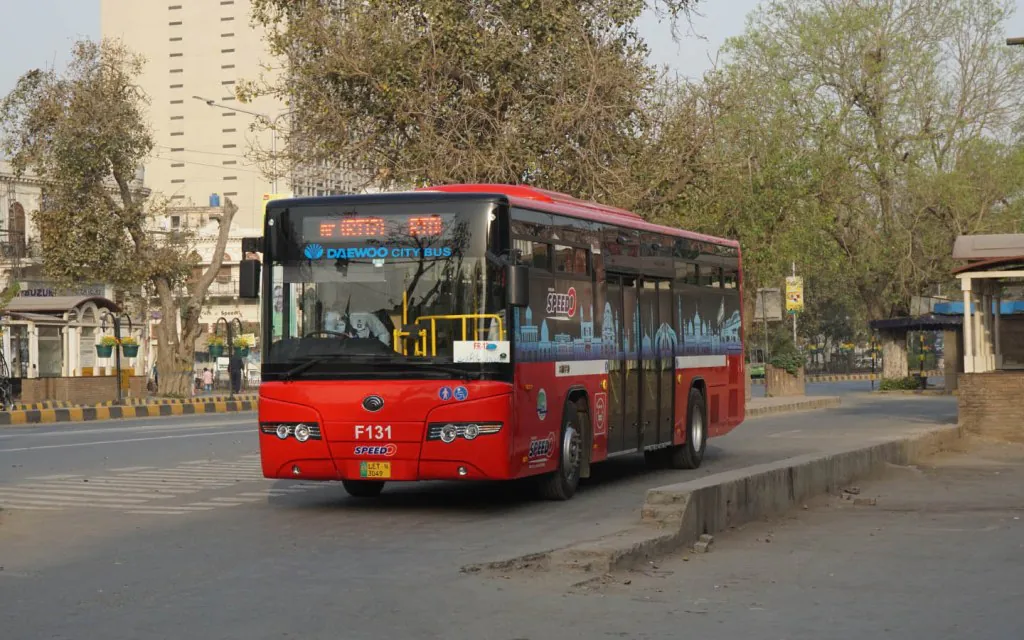
Metro Bus in Lahore Route Map
Because the Punjab Mass Transit Authority (PMA) established a feeder bus network, the Metro Bus Lahore route is a straight corridor that is not easily accessible from many parts of the city. Feeder bus routes span too many different areas of Lahore and frequently intersect, ensuring Lahore Metro Bus passengers have a smooth ride.
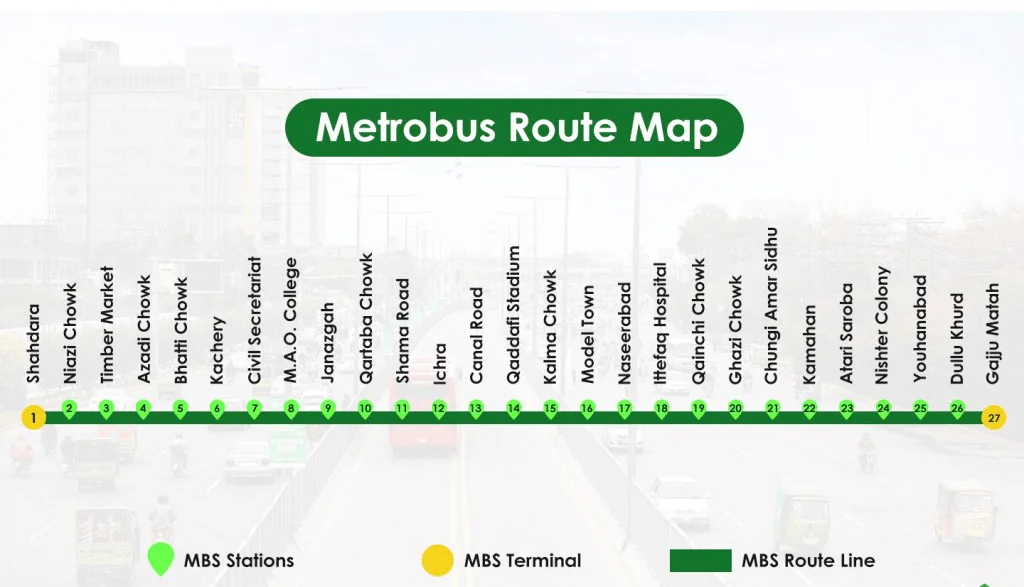
Following is the detail of Lahore Metro Bus routes:
| Route Number | Route Details |
| 1 | Railway station to Bhatti Chowk |
| 2 | Bhatti Chowk to Samanabad Morr |
| 3 | Railway Station to Rana Town |
| 4 | R.A. Bazar to Chungi Amar Sidhu |
| 5 | Shadhbagh Underpass to Bhatti Chowk |
| 6 | Babu Sabu to Raj garh chowk |
| 7 | Bagrian to Chungi Amar sidhu |
| 8 | Canal Road to Daewoo Terminal |
| 9 | Railway station to sham Nagar |
| 10 | Multan chungi to qartaba chowk |
| 11 | Babu Sabu to Gulberg main market |
| 12 | R.A. bazaar to civil secretariat |
| 13 | Bagrian to kalma chowk |
| 14 | R.A. bazaar to purana kahna |
| 15 | R.A. Bazar to Bhatti Chowk |
| 16 | Canal Road to Thokar Niaz Baig |
| 17 | Gajju Matah to PKLI |
There is a metro station almost every km along the route. The Lahore Metro has an intelligent transportation system. Every day, this transportation network transports over 200,000 people. This metro bus network’s highlights include automatic off-board fare collection, well-designed stops, bus schedules, vehicle location, passenger information, and precise bus-docking.
Other cities have bus services as well; Karachi has a Karachi Green Line Bus. Lahore Metro Bus Service operates and covers the entire capital city of Punjab, with 27 metro Bus stations.
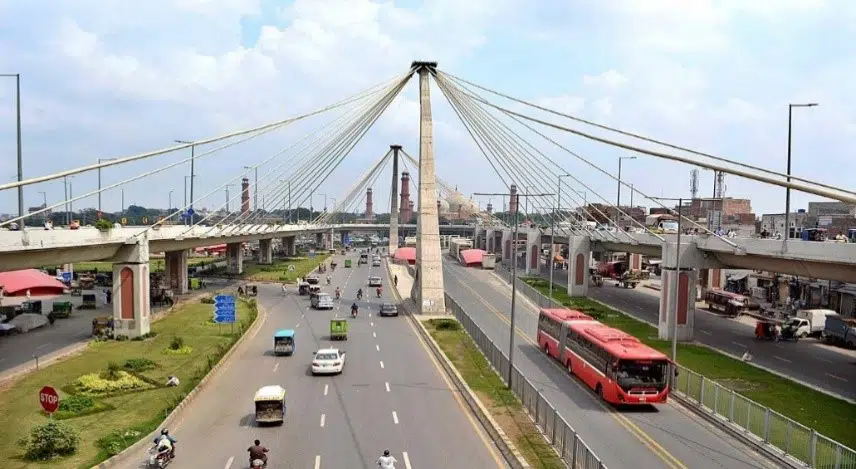
Stations
The Lahore Metro is a fast, safe, and comfortable bus transit system in Lahore. Together with the Orange Line Metro Train, the Metro Bus Service forms a comprehensive urban transportation system. On a 28.7-kilometer route, the Lahore Metro operates a fleet of 66 air-conditioned buses.
- Ichhra
- Atari saroba
- Niazi chowk
- Azadi chowk
- Shahdra chowk
- Timber chowk
- Katchery
- Civil secretariat
- Naseerabad
- Canal
- Qartaba chowk
- Bhatti chowk
- Shama
- Chungi Amar Sidhu
- Qaddafi stadium
- Mao college orange line
- Janazgah
- Kalma chowk
- Youhanabad
- Model town
- Nishtar
- Dulu Khurd
- Gajjumata terminal
- Itefaq hospital
- Shahdara terminal
- Qainchi
- Kamahan
Timings
The Lahore metro bus service serves the entire city of Punjab, with 27 stations and various routes. It also has its own set of timings to ensure proper operation. The Metro bus runs from 6:00 a.m. to 11:00 p.m.
Central Line Timings:
6:15 am – 10:00 pm
Interval Between the Departure of Buses (Peak hours)
2.25 minutes to 3 minutes
Timings for Feeder Buses
6:00 am – 11:00 pm
Interval Between the Departure of Feeder Buses
5 to 10 minutes (Peak Hours)
10 to 15 minutes (Off-Peak Hours)
Ticket price
Lahore Metro bus service offers two types of ticketing systems:
Single-ride tokens cost Rs. 30 and are available at Metro Bus Station ticket booths or self-service Ticket Vending Machines (TVM).
Metro bus cards can be used on multiple trips, eliminating the need to wait in line for a token. These cards are provided free of charge at Ticketing Offices upon presentation of your national identity card or Form-B. (if you are younger than 18). These cards can be topped up to a maximum of Rs. 1000 at TVMs. The same card was used on Metro Bus feeder lines.
How to get a ticket?
For traveling on a metro bus in Lahore, one must carry a ticket to easily get on the bus. Ticket is in the form of
- Tokens
- Metro Card
HOW TO GET METROBUS CARD?
If you use the Lahore Metrobus frequently, purchasing a Metrobus Card is the best option for you because it eliminates the hassle of standing in long lines and purchasing tokens each time you travel.
When purchasing a Metrobus Card, you must pay a security deposit of PKR 130, which is refundable when the card is returned. Once you have your card, you can recharge it for up to PKR 1000 at a Ticket Vending Machine (TVM) or a ticketing booth near you.
FARE POLICY FOR METROBUS CARD USERS
With a Metrobus Card, you can enjoy benefits such as discounted fares and a special integrated fare policy that allows you to pay a one-time fee for up to three trips (each trip should be of 30 minutes max)
The following is the fare policy for Metrobus Card users in Lahore:
Single Trip: PKR 15
Two Trips: PKR 20
Three Trips: PKR 25
Token
Tokens can only be used for one trip. These tokens can be purchased at the ticket office or from the self-service Ticket Vending Machine at each Metrobus Station (TVM). There is no need for a security deposit; however, the corresponding fare must be deposited at the ticket office or TVM.
Tokens must be tapped at the platform’s entry turnstile, kept during the journey, and then deposited at the platform’s exit turnstile as it is exited. It is prohibited to purchase Tokens for multiple rides and carry them out of the Metrobus Station.
Metro Cards
Metrobus Cards are durable and employ secure RFID technology. These cards can be purchased from the ticket office at any Metrobus Station for a Rs 130 security deposit, as long as the card is returned in good working order. The Metrobus Card in Pakistan’s Metrobus System can be obtained through TVM.
People with enough money on their Metrobus Cards can travel directly to the platforms at each station. The Metrobus Card and its balance have no expiration date. Metrobus Cards must be touched at the platform’s entry turnstile, kept throughout the journey, and then tapped again as you exit.
Fare policy
Metro bus service in Lahore is using a ticket of Rs.30. After taped at the entry turnstile, the traveler must go from the system within one hour and 15 minutes. Passengers who stay longer than this pay an additional price.
Passengers who have a Metrobus card can take three trips for the price of one.
A single ride costs Rs. 15.
A two-journey fare costs Rs. 20.
Three journeys cost Rs.25 each.
DESIGN, FEATURES AND INFRASTRUCTURE
Keeping the Institute for Transportation and Development Policy’s criteria in mind, the design and infrastructure for Lahore’s Metro Bus have been outfitted with all of the latest features. The system is equipped with automated off-board fare collection. Metro Bus Stations in Lahore also have well-designed signboards that help people find their way around the stations.
During peak hours, a bus usually departs from the station every two minutes to prevent the vehicles from becoming overcrowded with commuters. Furthermore, for the convenience of commuters, Metro Bus Stations in Lahore include parking spaces for vehicles such as cars, motorcycles, and bicycles. Because Metro Buses in Lahore run on completely separate corridors with elevated rotaries that are rarely obstructed by traffic,
HISTORY AND CONSTRUCTION OF LAHORE METROBUS SYSTEM
Following in the footsteps of Turkey’s Istanbul Metrobus System, the Punjab government, in collaboration with the federal government, proposed Pakistan’s first BRT system in Lahore. The Lahore Metrobus project began in 2012, and it was completed in phases, with packages handed over to various contractors for the provision of various types of raw materials used in construction.
The Traffic Engineering and Planning Agency (TEPA), a subsidiary of the Lahore Development Authority, spent approximately PKR 29 billion on the development of Lahore’s Metro Bus System (LMBS) (LDA). The much-anticipated launch of Lahore’s Metro Bus occurred in February 2014; since then, this transportation system has been providing services.
CONCLUSION
This concludes our comprehensive guide to the Lahore Metrobus system. If you’re in the capital, don’t miss our piece on Islamabad’s Metro Bus System, which can provide you with information on its routes, fare policies, and timings.

